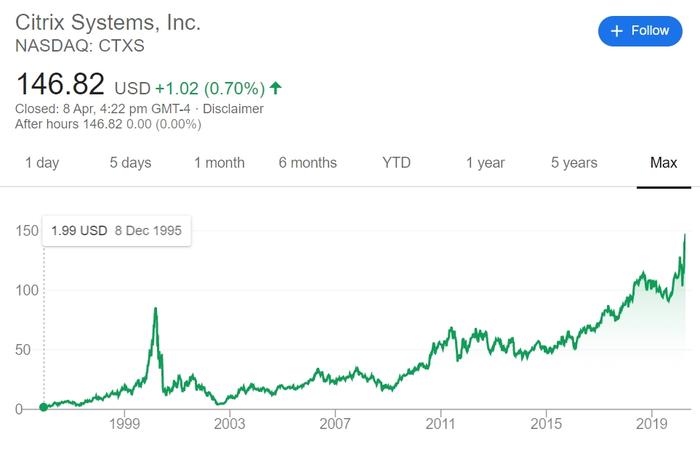Citrix pushes design thinking to supercharge its channel
- 17 April, 2020 11:30

Brian McColm (Citrix)
With its share price near all-time highs, Citrix Systems is proving to be one of the most resilient vendors in the era of Covid-19.
It is also a very channel focused business, which is urging its partners to think differently about the way they engage with customers.
Brian McColm, Citrix’s director of channels for the Australia and New Zealand, told Reseller News last month he was working with the channel on differentiation through applying "design thinking", a set of methodologies and techniques that emerged in the 1960s and gained widespread adoption from the 1980s.
"If everybody is doing the same thing, it comes down to a price conversations so we are working with partners on differentiation," he said.
Opportunities for partners include the remote workspace technology Citrix is most famous for but also building template and flow-driven micro apps to increase productivity, applying workspace intelligence and working with customers on how to use the technology.
User centred design thinking has been a big part of Citrix's mantra for a decade, a period in which the company has gone from being perceived as under threat to an industry standout.
In a 2015 interview with McKinsey, Citrix senior VP of customer experience Catherine Courage said traditionally, many of the company's product organisations would start with a problem and then -- based on intuition about what our customers want -- race toward a solution.
"Today, they actively engage customers along the way, with an iterative process of failing and learning fast as part of the journey," she said.
"Getting to this point has required big process changes and a new mind-set across the company."
Citrix's embrace of design thinking neatly coincided with a business and perception turnaround that has lifted the company's share price from around US$35 in 2010 to push past US$150 this week (see chart below).
 Credit: Google
Credit: Google Over the same decade, revenue increased from US$1.9 billion to over US$3 billion.
That period also marks Citrix's transition from being a 30-year provider of desktop virtualisation technology on perpetual licences to the cloud and a subscription model.
McColm, who spent twenty years at Cisco before moving to Citrix in mid-2017, said design thinking is an opportunity for partners to engage and ask questions about what their customers use and how they use it and then to find ways to improve that and add value.
It is also an opportunity to clearly define their value propositions and the technology they can bring to bear on customer challenges.
Read more on the next page...
Page Break
Many partners have also been selling virtualisation to the same customer bases for a long time but there is an opportunity to extend into new markets and drive cloud adoption, McColm said.
The addressable market for Citrix partners has shifted and grown from simply virtualisation to embrace the delivery of intelligent digital workspaces including hybrid cloud and SaaS-based applications.
"It's also about the experience side of things for people now," McColm said. "Employee experience is one of the things we are focusing on in terms of the digital workspace."
Citrix is aiming to deliver a more consumer-like, intelligent and at the same time a more secure experience.
Delivering that improved employee experience presents a significant opportunity for partners and is a large part of what digital transformation is all about.
McColm said Citrix's digital workspaces embrace not just applications but desktops and files as well and that is helping the company to grow and become even more relevant today than in the past.
In-built analytics can also deliver customised experiences, performance and rules-based security depending on, for instance, where the user is working from and what they are doing.
That combination, and the opportunity to link the digital workspace with Citrix's networking technology, is what can also translate into higher profitability for channel partners.
"We are basically raising the stakes," McColm said. "If I said to you that 15 per cent of a company's workload is typically through virtualisation that leaves 85 per cent of SaaS based or other apps that you can add value to from a partner perspective.
"Whether they are SaaS-based, web based or virtualisation, they all sit within the workspace."
After what could be seen as a slow start, cloud subscriptions are being deployed rapidly and accounted for around 70 per cent of Citrix's business last year.
"That's quite a rapid movement in a fairly short period of time," McColm said.
For its part, Citrix is investing in customer success managers and providing partners with best practice and to expand into new use-cases.
"We're helping on developing service capabilities, helping them drive adoption, helping them in terms of accelerating customer adoption of the cloud.
"If you do that you are selling to IT and the business. It's not just an IT conversation."
Partners therefore have four broad opportunities: to sell what they are doing today, to sell more to existing customers, to sell new technologies and services to existing customers and sell to new customers and new markets.
"There's a lot of work from the partner account managers focusing on partners on those four priorities from a channel perspective: to differentiate offerings, develop service capabilities for cloud adoption, accelerate customers to the cloud and increase reach to market."
In Australia NTT, Data3 are significant partners as well as large global systems integrators such as Fujitsu and DXC.
In New Zealand, partners come from both the end user computing area -- often Microsoft partners -- and some from a networking perspective.
Spark is a major partner as are Datacom, Fujitsu, Auckland-based platinum partner Deptive and Christchurch's Inde.
McColm said Citrix also works closely with Microsoft, AWS and Google and wants to do more with "born in the cloud" type partners.

